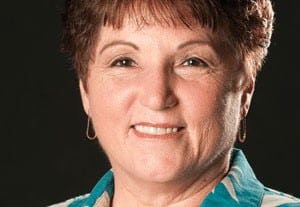UAMS’ Cutting-Edge Skin Cancer Treatment Reverses Sun Damage
| Coleen Hyde has fond memories of idyllic days in the sun during her youth. Living in California near the coast, deep tans were in vogue, sunscreen was not widely available at the drug stores and she wasn’t aware of damage from the sun’s rays.

Coleen Hyde, a skin cancer patient, shown after her treatment at UAMS.
After she moved to Arkansas 22 years ago, Coleen began using sunscreen and taking care of her skin. But she became concerned about some irregularities on her skin and began seeing a dermatologist to have suspicious growths removed. When Coleen learned of Mohs micrographic surgery at the UAMS Winthrop P. Rockefeller Cancer Institute, she was relieved to find state-of-the-art treatment for skin cancers on her face and neck.
Skin cancer doesn’t have an age or a face — 90% of all melanomas are related to time in the sun, and melanoma is one of the most common cancers in people under the age of 30. Also, people of all skin tones can get skin cancer and need to use sunscreen. But most importantly, melanoma is aggressive and can be deadly, so early intervention is crucial.
With up to a 99% success rate, Mohs micrographic surgery is one of the most advanced and effective surgical methods for treating skin cancer. Using this procedure, malignant skin cancers are removed in thin, pie-shaped pieces and examined immediately under a microscope to determine if all malignant tissue was removed. UAMS surgeons work to remove the skin cancer while ensuring the best possible cosmetic appearance for patients.
In April of 2012, Coleen thought she would have a small growth on her nose removed but was dismayed to learn that damage under the skin was more extensive than she anticipated. During her Mohs procedure at UAMS, she was consulted and offered options during every step of the process. Even though skin grafting was required, Coleen was pleased with the expertise of her surgical team and the results. She was also relieved to know that since Mohs is a minimally invasive procedure, she would not need to be put to sleep or confined to a hospital bed.



Stephen D’Addario, M.D., a former dermatologist in the UAMS Dermatology Cancer Clinic, performed Coleen’s procedure. “Most of my patients who receive this procedure have years of sun exposure as a result of living in the south or coastal areas of the country. Most estimates assume up to 80% of our sun damage has occurred before a patient reaches the age of 18. The Mohs surgical procedure is ideal for treating skin cancer on the face and neck areas because we can spare healthy tissue and reduce scarring.”
Since Dr. D’Addario is also trained in many cosmetic procedures, he is able to combine Mohs surgery along with other procedures to ensure the best outcome for his patients. Coleen said, “I was anxious, but Dr. D’Addario and his team were very diligent, providing extra care and concern. In addition to wonderful results that were achieved by Dr. D’Addario’s abilities, the entire team treated me with courtesy and respect.”
For patients who don’t have skin cancer but want to improve skin imperfections due to sun damage, the UAMS dermatology services offers a wide range of cosmetic procedures. Also, he wants his patients to understand the importance of using sunscreen to avoid skin cancers. “Sunscreen must be used more than once a day; the reapplication is very important. Often I can reverse some signs of sun damage, but you need to be diligent in your sun protection by using a sunscreen of 30 or higher, and reapply it every three to four hours.”
To learn more, please visit UAMShealth.com/dermatologycancer.
